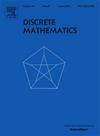随机d正则图中的跳跃强迫数
IF 0.7
3区 数学
Q2 MATHEMATICS
引用次数: 0
摘要
跳跃强迫是一种单人组合游戏,在这种游戏中,玩家会看到一个包含n个顶点的图表,其中一些顶点最初是蓝色的,其余顶点是白色的。在每一轮t中,一个蓝色的顶点v与所有的邻居都是蓝色的,可以在第二个邻居中跳跃并将一个白色的顶点涂成蓝色,前提是v在之前的t−1轮中没有进行跳跃。游戏的目标是通过反复使用跳跃强迫规则将每个顶点涂成蓝色。随后,对于给定的图G,跳跃强迫数为达到目标所需的最小初始蓝色顶点数。本文研究了随机d正则图的跳强迫数。具体地说,我们的目的是推导出d≥2的各种值的跳跃强迫数的渐近上界和下界。本文章由计算机程序翻译,如有差异,请以英文原文为准。
Hopping forcing number in random d-regular graphs
Hopping forcing is a single player combinatorial game in which the player is presented a graph on n vertices, some of which are initially blue with the remaining vertices being white. In each round t, a blue vertex v with all neighbours blue may hop and colour a white vertex blue in the second neighbourhood, provided that v has not performed a hop in the previous rounds. The objective of the game is to eventually colour every vertex blue by repeatedly applying the hopping forcing rule. Subsequently, for a given graph G, the hopping forcing number is the minimum number of initial blue vertices that are required to achieve the objective.
In this paper, we study the hopping forcing number for random d-regular graphs. Specifically, we aim to derive asymptotic upper and lower bounds for the hopping forcing number for various values of .
求助全文
通过发布文献求助,成功后即可免费获取论文全文。
去求助
来源期刊

Discrete Mathematics
数学-数学
CiteScore
1.50
自引率
12.50%
发文量
424
审稿时长
6 months
期刊介绍:
Discrete Mathematics provides a common forum for significant research in many areas of discrete mathematics and combinatorics. Among the fields covered by Discrete Mathematics are graph and hypergraph theory, enumeration, coding theory, block designs, the combinatorics of partially ordered sets, extremal set theory, matroid theory, algebraic combinatorics, discrete geometry, matrices, and discrete probability theory.
Items in the journal include research articles (Contributions or Notes, depending on length) and survey/expository articles (Perspectives). Efforts are made to process the submission of Notes (short articles) quickly. The Perspectives section features expository articles accessible to a broad audience that cast new light or present unifying points of view on well-known or insufficiently-known topics.
 求助内容:
求助内容: 应助结果提醒方式:
应助结果提醒方式:


